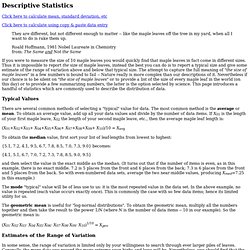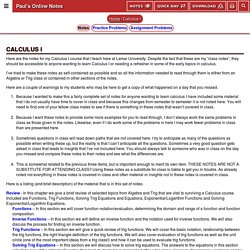

Descriptive Statistics. Click here to calculate mean, standard deviation, etc Click here to calculate using copy & paste data entry They are different, but not different enough to matter -- like the maple leaves off the tree in my yard, when all I want to do is rake them up.

Roald Hoffmann, 1981 Nobel Laureate in Chemistry from: The Same and Not the Same If you were to measure the size of 10 maple leaves you would quickly find that maple leaves in fact come in different sizes. Thus it is impossible to report the size of maple leaves, instead the best you can do is to report a typical size and give some estimate of the range of variation above and below that typical size. Typical Values There are several common methods of selecting a "typical" value for data. (X01+X02+X03+ X04+X05+X06+ X07+X08+X09+ X10)/10 = Xavg To obtain the median value, first sort your list of leaf-lengths from lowest to highest: {5.1, 7.2, 4.1, 9.5, 6.7, 7.8, 8.5, 7.0, 7.3, 9.0} becomes: (X01·X02·X03· X04·X05·X06· X07·X08·X09· X10)1/10 = Xgeo.
How to construct a 60 degree angle with compass and straightedge or ruler. Geometric Constructions. List of Geometric Shapes. "Math Salamanders Free Math Sheets" Welcome to the Math Salamanders' Geometric Shapes Information Page.

Here you will find a list of different geometric shapes to help you to identify a range of 2d and 3d shapes. How to Print or Save these sheets Follow the 3 easy steps below to get your worksheets printed out perfectly! Step 2 Magnify it (if needed). Need further help? Need help with printing or saving?
How to Print support List of Geometric Shapes Here you will find our list of different Geometric shapes. There is an image of each shape, as well as the properties that the shape has. Know the properties of different 2d & 3d shapes; recognise different 2d & 3d shapes; know the interior angles of regular polygons; All the Math sheets in this section follow the Elementary Math Benchmarks. 2d Geometric Shapes Here are our list of 2d geometric shapes, including triangles, quadrilaterals and polygons.
Prism, Pyramid, Cylinder, Cone,Sphere and other Solid Geometric Shapes – Definitions, Area and Volume formulas « Lia's Math. Prism, Pyramid, Cylinder, Cone,Sphere and other Solid Geometric Shapes – Definitions, Area and Volume formulas Below is a table with definitions, area and volume formulas, for the body shapes shown on the right hand side. For a table with perimeters and areas for the most common 2D shapes, click here. Ohiomath. Calculus I. Show Mobile NoticeShow All NotesHide All Notes You appear to be on a device with a "narrow" screen width (i.e. you are probably on a mobile phone).

Due to the nature of the mathematics on this site it is best views in landscape mode. If your device is not in landscape mode many of the equations will run off the side of your device (should be able to scroll to see them) and some of the menu items will be cut off due to the narrow screen width. Here are the notes for my Calculus I course that I teach here at Lamar University. Despite the fact that these are my “class notes”, they should be accessible to anyone wanting to learn Calculus I or needing a refresher in some of the early topics in calculus. I’ve tried to make these notes as self-contained as possible and so all the information needed to read through them is either from an Algebra or Trig class or contained in other sections of the notes.
Here is a listing (and brief description) of the material that is in this set of notes. Math Insight thread: Calculus Refresher. Calculus I. Quadratic Equations. An example of a Quadratic Equation: The name Quadratic comes from "quad" meaning square, because the variable gets squared (like x2).

It is also called an "Equation of Degree 2" (because of the "2" on the x) The Standard Form of a Quadratic Equation looks like this: Here are some more examples: Hidden Quadratic Equations! So the "Standard Form" of a Quadratic Equation is ax2 + bx + c = 0 But sometimes a quadratic equation doesn't look like that! How To Solve It? The "solutions" to the Quadratic Equation are where it is equal to zero. They are also called "roots", or sometimes "zeros" There are 3 ways to find the solutions: 3.
Just plug in the values of a, b and c, and do the calculations. We will look at this method in more detail now. About the Quadratic Formula Plus/Minus First of all what is that plus/minus thing that looks like ± ? But sometimes you don't get two real answers, and the "Discriminant" shows why ... Engineering Archives - L - Understanding a Log-Log Graph.